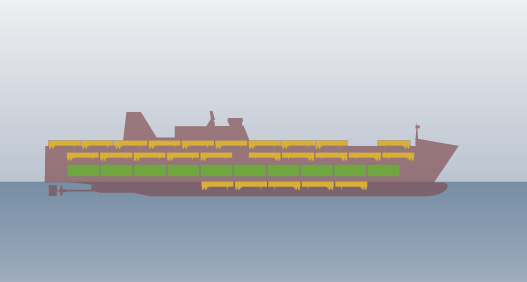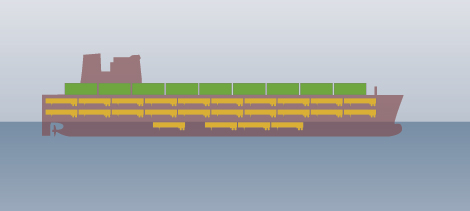When the Maritime Administration (MarAd) unveiled a series of new vessel designs late last year, it promoted them primarily as a way to make the American Marine Highway a reality. But the U.S. Navy has its own interest in the project, as a low-cost way to replace its rapidly aging fleet of sealift ships. And it's splitting the cost of developing them.
The 11 concepts proposed by Herbert Engineering range widely in size and configuration. But the vessels designed to carry 53-foot over-the-road trailers rather than standard shipping containers hold particular interest for the Navy because of their military utility.
 |
|
Among the U.S. Maritime Administraton's proposed ship designs is this 682-foot roll-on, roll-off vessel. It can fit 151 53-foot trailers, plus 104 containers. Cruising speed is 24 knots. (Virginia Howe illustration/Source: MarAd) |
"Take a look at the designs that we're focusing on," Jonathan Kaskin, the Navy's director for strategic mobility and combat logistics, said in an interview. "They're either full trailer ships or (roll-on roll-off) types or they have the capability of moving boxes on cassettes." Cassettes allow trailers to be stacked two high.
Two of the concepts Kaskin discussed are MarAd's designs numbered 3 and 4. One is a 682-foot ro-ro that can carry 151 53-foot trailers plus 104 53-foot containers stacked double high on cassettes. The other is a smaller ro-ro, at 602 feet, but the capacity is greater — 154 trailers plus 160 containers, achieved by stacking the boxes two high on cassettes on the upper deck. The first has a design speed of 24 knots, the second 20 knots; both have a draft of 23 feet.
 |
|
Another MarAd design is a 602-foot ro/ro that can carry 154 trailers below-deck. As many as 160 containers can be double-stacked on the main deck. Cruising speed is 20 knots. (Virginia Howe illustration/Source: MarAd) |
Kaskin said two existing ships with similar cargo characteristics are the Orca-class trailerships delivered to TOTE in 2003 by General Dynamics Nassco for the Alaskan trade.
"We had no impact on the design of those ships," said Kaskin. "But the ships as currently constructed are fully capable of carrying practically any type of military equipment that they have in Alaska."
The only addition the Navy made was to fund the purchase of an external ramp that allows either ship to offload overseas, Kaskin said. The Navy needs to recapitalize its aging sealift fleet — the surge vessels needed to rush materiel to a combat zone.
"Over the next decade, we're OK until about the mid-'20s, and then — the Ready Reserve Force begins to age out," said Kaskin. "The average age right now is around 34 years."
"The reason that a ship on the Marine Highway is very useful to us is that it's available quickly," Kaskin said. "We understand that getting the Marine Highway started isn't going to be an instantaneous exercise — that it's going to take some time to get everything in place. But that's why we're starting now."
Kaskin stressed that at this stage, the Navy is far from endorsing dual-use Marine Highway vessels as the answer to its sealift needs, and said details such as freight subsidies and compensation to vessel owners are all open to discussion. "The reason that we're putting them out there is to get feedback," he said.
At the same time, the Navy is concerned that its policy of keeping purpose-built ships in reserve for sealift is becoming prohibitively expensive, and not just in terms of replacement. Kaskin estimated the annual cost of maintaining its Fast Sealift Ships, at about $7 million.
"The Department of Defense is going to be under severe budgetary pressure over the next several years, and the likelihood of us recapitalizing our sealift fleet — it can't be done by building new ships and laying them up anymore," Kaskin said. "We don't have those resources."
A couple of naval architects expressed surprise that MarAd would have paid for design concepts for Marine Highway vessels, since several already exist. Herbert Engineering's report, which cost $400,000, lists six, including two of its own. And VT Halter Marine in Pascagoula, Miss., is currently building a ro-ro for Pasha Hawaii Transport Lines.
MarAd Administrator David Matsuda said in an interview that the intention was to "seed the private sector" and nudge it toward making the Marine Highway a reality. "We have to be involved if we want the kind of benefits we're looking at."
Asked about interest from shipyards, Matsuda said: "We've had interest from a couple of yards." He said Nassco has "done a lot to promote Marine Highway vessels." Huntington Ingalls’ yard in Avondale, La., was another possibility. "This community has a strong desire to keep that facility open," he said.
Because one purpose of the American Marine Highway is to reduce pollution from trucks on interstate highways, MarAd is looking at burning LNG instead of diesel as a vessel fuel. That won't work for the Navy, which needs to be able to burn diesel offshore. Kaskin said the Navy is helping fund a dual-fuel ship design.
